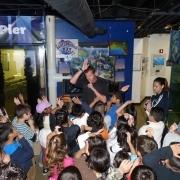Heal the Bay is joining the fight to protect sharks this Earth Month by promoting legislation that would outlaw the sale of shark fins. Sign now!
Every year, fins from tens of millions of sharks are used for shark fin soup. The human appetite for shark fins is a major contributor to the near collapse of shark populations worldwide, including in California. One of the most effective ways to protect sharks is to eliminate the market for fins by prohibiting their sale. AB 376, a bill being considered in the California state legislature, will ensure stronger protections for sharks by banning the possession, sale, trade and distribution of shark fins. Hawaii and the Commonwealth of Northern Mariana Islands have recently passed similar legislation, and Guam, Oregon, and Washington state legislatures are also considering similar bans.
The ruthless practice of shark finning (which leaves live animals finless and unable to swim) remains legal in many parts of the world. It is dangerously efficient because it enables fishing crews to throw out low-value, unmarketable shark carcasses and retain only the fins. As predators at or near the top of marine food webs, sharks help maintain the balance of marine life in our oceans. Research shows that the massive depletion of sharks has cascading effects throughout the oceans’ ecosystems. AB 376 will give critical protection to sharks and preserve the health of our oceans.
California represents a significant market for shark fins in the United States, and this demand helps drive the practice of shark finning and declining shark populations. San Diego and Los Angeles are two of the top U.S. entry points for shark fin imports. Most fins are processed in Asia and exported around the world, and fins sold in California may come from these markets.
Although shark fin soup has long been a popular entrée because of its association with prestige and privilege, concerned individuals across Asia – including China, Taiwan, Singapore and Hong Kong – have formed shark protection groups to highlight the plight of sharks. Some governments and businesses in the Pacific region have pledged to not serve shark fin soup at government functions, business meetings and celebratory banquets. Likewise, a growing number of globally recognized Asian chefs support alternatives to shark fin. We recognize the cultural importance of shark fin soup as a ceremonial dish, and the sacrifice that the Chinese community in California will be making to give it up in their support of ocean health. This leadership is also reflected by the group of respected Asian Pacific American leaders, elected officials, celebrities and advocates that have joined in support for AB 376.
Look out for petitions during Earth Month at Heal the Bay booths at festivals and fairs, or get more information when you stop by our Santa Monica Pier Aquarium during public hours, or at the Victor Douieb Shark Sculptures Premiere.
ACT NOW: Sign the petition to end shark fin sales in California.
Photo: USFWS Pacific via Flicker



